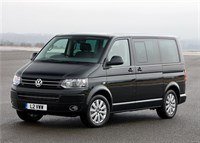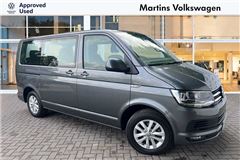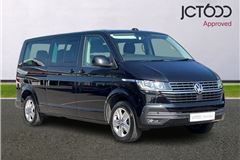Volkswagen T5 Caravelle (2010 – 2015) Review
Volkswagen T5 Caravelle (2010 – 2015) At A Glance
As luxurious and genuinely spacious people carriers go, few vehicles are as good as the Volkswagen Caravelle. As is pretty obvious, it's based on the Volkswagen Transporter van, so the boxy shape means there's masses of space in the back and it can carry seven adults in real comfort.
You're probably more familiar seeing the Caravelle being used by hotels and airports, or as an upmarket private hire vehicle, but it's ideal as a family carrier too - especially if you have a large family. It's very versatile thanks to rails that are integrated into the floor and allow the second and third row of seats (and the clever multifunction table) to be moved backwards or forwards to maximise luggage space or legroom.
The rear bench can also be converted into a large, almost completely flat bed. Plus there's an optional 'sleep pack' which can turn the Caravelle into a campervan with a bed extension for the rear seats and additional blinds for the windows.
This 2010 Volkswagen Caravelle isn't actually all new, it's a thoroughly revised versios of the T5 Caravelle from 2003, but there are key changes, particularly inside where there's a high-class interior that's very similar to Volkswagen passenger cars like the Golf. It also uses Volkswagen's 2.0 TDI common rail diesel which is far smoother and quieter than the previous diesels in the Caravelle range.
This newer engine is also more economical and has longer service intervals than before which means lower running cost. However the Caravelle is still expensive to buy new, especially when there are cheaper seven-seaters available - although few are as upmarket as the Volkswagen.
Driving the Volkswagen T5 Caravelle (2010 – 2015)
Strangely, the Caravelle comes with 'sports' suspension as standard (except for the SE long wheelbase version) which does seems very odd for a luxury people carrier. It also means the ride is a quite firm and doesn't deal especially well with rough or bumpy roads, where there can be a fair amount of vibration through the cabin.
It's much better on smooth roads such as motorways, where it makes serene and comfortable progress. There's good performance from both engines too, even with a full load of passengers and luggage on board. The 2.0 TDI unit - available with either 140PS or 180PS - is a common rail engine which means it's far more refined that the older 1.9 TDI and 2.5 TDI engines from the previous Caravelle.
This newer 2.0 TDI engine also offers better performance. The 140PS version is the most popular and develops 340Nm of torque - the same as the previous 2.5-litre 130PS engine; however, it's far quicker and will accelerate from 0-62mph three seconds faster, while official average economy is 36.7mpg (compared to 34.0mpg before). CO2 emissions are also lower. However, due to its sheer size, the Transporter never truly impresses on the economy front, with most models struggling to surpass 30mpg, while emissions range from 189 - 225g/km of CO2.
The top engine is the superb 2.0 BiTDI 180PS which has two turbochargers of different sizes. At low engine speeds, the larger turbo delivers steady boost, but at higher speeds the smaller turbocharger gives additional power. It has an immense 400Nm of torque from only 1500rpm but still averages a claimed 37.2mpg.
Both engines come with a six-speed manual gearbox as standard. This has a very positive shift action, helped by a gear lever that's mounted high-up on the dash, very close to the steering wheel. Volkswagen's excellent DSG double clutch automatic gearbox is also available as an option. It delivers mostly smooth shifts and works particularly well with this engine, although it does suffer the odd moment of hesitation on the upshift.
On the move the Caravelle is easy to drive and doesn't feel like a bulky or large vehicle. Of course, parking is never going to be very easy in a vehicle that's almost five metres long (longer in the case of the LWB model), but the steering is light when manoeuvring and there's good visibility, helped by the vertical rear, so judging distances is made less daunting. Parking sensors aren't standard which is a little disappointing, but they are available as an optional extra.
Volkswagen T5 Caravelle (2010 – 2015) interior
A key change for the 2010 Caravelle is found in the cabin; it retains the same excellent build quality and high class finish as before, but it's been redesigned with a layout and features taken from Volkswagen's car range - so it feels very similar to a Volkswagen Golf with the same leather three-spoke steering wheel, ventilation controls and instrument dials.
Long distance comfort is a big strength too and both the driver and passenger seats are multi-adjustable with improved side support and an integrated lumbar cushion, while the steering column adjusts for reach and height, so getting comfortable behind the wheel is simple, whatever shape you are.
But it's the rear passenger space of the Caravelle which really matters - this is a full size people carrier after all. It doesn't disappoint either with acres of space and a high quality feel, plus it's incredibly versatile with plenty of useful touches, like large sliding doors on both sides which make getting in and out very simple.
The four floor-mounted rails allow all the seats in the back slide to any position plus the the two individual seats in the middle row can be swivelled around to face the rear bench to create a lounge environment, or they can be moved well back to increase passenger legroom. If you don't need seven seats there's an optional six seat layout which has two individual rear seats in place of the three-seat bench.
The rear bench seat is also mounted on the rail system and can be slid forward to increase boot space. It can also be removed (to create a van-like load area) but it's a struggle even with two people, as it's heavy and bulky. The bench can be converted into a large, almost completely flat bed by pulling a lever and pushing the recliner back and down. There's also an optional 'sleep pack' that turns the Caravelle into a campervan with a bed extension for the rear seats and additional blinds for the windows.
One of the best features if you have children is the useful central table which can be moved forwards or backwards on the rail system and also folded out into a variety of sizes, heights and positions. It features two storage compartments for drinks bottles (accessible even when the table is not folded out), a drawer, a tray for small items, and cupholders.
Volkswagen T5 Caravelle (2010 – 2015) models and specs
| Dimensions | |
|---|---|
| Length | 4892–5292 mm |
| Width | 1904 mm |
| Height | 1970–1990 mm |
| Load Volume | 5.8–6.7 m3 |
| Miscellaneous | |
|---|---|
| Kerb Weight | 2287–2572 kg |
| Payload | 507–713 kg |
| Warranty | 36/100,000 24/Unlimited |
| Servicing | Variable |
Minibus LWB
| Version | List Price | MPG | |
|---|---|---|---|
| SE LWB 2.0BiTDI 180 BlueMotion Tech | £32,510 | 38.7 mpg | Details |
| SE LWB 2.0BiTDI 180 BlueMotion Tech DSG | £34,110 | 37.2 mpg | Details |
| SE LWB 2.0BiTDI 180PS | £30,178 | 36.2 mpg | Details |
| SE LWB 2.0BiTDI 180PS DSG | £31,578 | 34.9 mpg | Details |
| SE LWB 2.0TDI 140 BlueMotion Tech | £30,790 | 39.2 mpg | Details |
| SE LWB 2.0TDI 140 BlueMotion Tech DSG | £32,390 | 36.7 mpg | Details |
| SE LWB 2.0TDI 140PS | £28,561 | 36.7 mpg | Details |
| SE LWB 2.0TDI 140PS DSG | £29,961 | 34.3 mpg | Details |
| SE SWB 2.0BiTDI 180 BlueMotion Tech | £30,690 | 38.7 mpg | Details |
| SE SWB 2.0BiTDI 180 BlueMotion Tech 4MOTION | £32,945 | 35.8 mpg | Details |
| SE SWB 2.0BiTDI 180 BlueMotion Tech DSG | £32,290 | 37.2 mpg | Details |
| SE SWB 2.0BiTDI 180 BlueMotion Tech DSG 4MOTION | £34,545 | 34.0 mpg | Details |
| SE SWB 2.0TDI 140 4MOTION BlueMotion Tech | £30,910 | 36.2 mpg | Details |
| SE SWB 2.0TDI 140 BlueMotion Tech | £28,970 | 39.2 mpg | Details |
| SE SWB 2.0TDI 140 BlueMotion Tech DSG | £30,570 | 36.7 mpg | Details |
Minibus SWB
Model History
- August 2009: First details of new Volkswagen Caravelle released
- December 2011: Volkswagen launched Caravelle Edition 25
August 2009
First details of new Volkswagen Caravelle released
Changes to the external design include new rear light clusters, chrome side trims, more aerodynamic door mirrors and an entirely new front using latest Volkswagen passenger car design for the grille and headlights.
Other new features include comfort and safety items such as three-spoke steering wheels, stylish new instruments, a recommended gear shift display, a USB ‘Media-in’ interface to connect external devices, and the latest audio and integrated, touchscreen, hard-drive navigation systems.
The new generation ESP (Electronic Stabilisation Programme) with hill-start assist and an emergency brake light function was also introduced across the range, while other new features include Volkswagen’s Side Assist lane change system, first seen in the Touareg, which warns the driver of anything in the vehicle’s blind spot, and a new TMD (Tyre Monitor Display) to alert the driver to any decrease in tyre pressures.
There is a new range of two quieter, more economical 2.0-litre four-cylinder common rail TDI engines. These offer power outputs of 140bhp and 180bhp, and both meet the latest Euro V emissions standard. The new models also benefit from the introduction of Volkswagen’s seven-speed DSG automatic transmission, which will also be available later in 2010 with the 4MOTION all-wheel drive system with fourth generation Haldex coupling for the first time. The new models arrived in selected Volkswagen Van Centres from January 2010.
December 2011
Volkswagen launched Caravelle Edition 25
Only 225 UK examples were available in the UK, all exclusively finished in Candy White, or optional Reflex Silver metallic paint, with unique styling cues to help this latest model stand out from the crowd. It was priced at £44,995.
The changes included a revised front bumper with contrasting satin black styling accents in the lower sections, xenon headlights with LED running lights and black highlights the length of the vehicle and on the roof, side sills and tailgate. Exclusive satin black 18-inch ‘Edition 25’ design alloy wheels add to the vehicle’s appearance.

.jpg?width=640&height=426&rmode=crop)
.jpg?width=640&height=426&rmode=crop)
.jpg?width=640&height=426&rmode=crop)
.jpg?width=640&height=426&rmode=crop)
.jpg?width=640&height=426&rmode=crop)
.jpg?width=640&height=426&rmode=crop)


 Similar cabin to Volkswagen car models, very quiet and refined on the move, luxury feel, plenty of rear space, strong performance from 2.0 TDI engine, upmarket looks.
Similar cabin to Volkswagen car models, very quiet and refined on the move, luxury feel, plenty of rear space, strong performance from 2.0 TDI engine, upmarket looks.
 There are considerably cheaper seven seat people carriers available, running costs are high, rear seats are heavy and awkward to lift out. Catastrophic engine problems with 2.0BiTDI after 60k miles.
There are considerably cheaper seven seat people carriers available, running costs are high, rear seats are heavy and awkward to lift out. Catastrophic engine problems with 2.0BiTDI after 60k miles.



